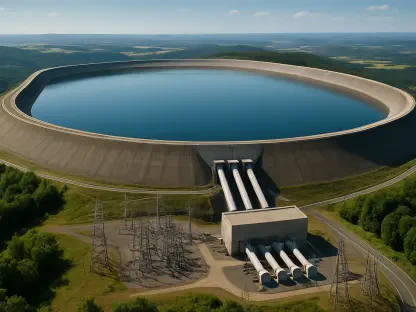The telecom and utility sectors are entering a transformative era shaped by artificial intelligence, heralding profound changes in network management and operational efficiency. As the demand for reliable and responsive networks intensifies, AI emerges as a critical tool in overcoming traditional industry challenges. The industries face the daunting task of maintaining vast infrastructures, where precise documentation and updates are vital yet laborious. AI’s ability to automate processes and analyze vast data sets swiftly provides a beacon of hope, promising enhanced accuracy, reduced human error, and improved resource allocation. The union of AI with network technologies has far-reaching implications, setting the stage for a future where intelligent systems not only streamline operations but also enable predictive maintenance and real-time decision-making.
Complementary Technologies in the Merger
IQGeo’s acquisition of Deepomatic signifies a significant step forward in the integration of AI within network frameworks. The collaboration between these companies is rooted in their shared vision of creating an intelligent ecosystem to support telecom and utility operations more efficiently. IQGeo brings robust geospatial technology into the fold, providing a platform for operators to visualize and manage physical networks comprehensively. This technology allows for the creation of a digital twin, effectively mirroring the real-world network to ensure seamless management across all stages of the network lifecycle.
Meanwhile, Deepomatic’s expertise in AI-powered computer vision technology opens avenues for sophisticated quality checks and data collection methods. Through computer vision, engineers can capture real-time photographs and interpret them intelligently, ascertaining the quality of installations with minimal manual intervention. The systems are designed to execute these tasks with high precision, examining everything from civil infrastructure to customer equipment. Deepomatic’s approach demonstrates that if a human can evaluate something visually, AI can replicate, and in some instances, surpass that perception.
The merger aligns perfectly with previous collaborations, deepening these integrations by leveraging technologies for enhanced field operations. By combining geospatial insights with computer vision capabilities, the two entities present a unified solution that addresses longstanding documentation challenges. Beyond the technical synergies, this integration offers practical benefits, ensuring operators maintain accurate records throughout network lifecycles and manage resources efficiently. The collaboration emphasizes the importance of embedding AI within existing frameworks for seamless operations without disrupting workflows.
Platform Integration and Efficiency
The integration process between IQGeo and Deepomatic platforms has proceeded smoothly, largely owing to the complementary nature of their respective technologies. Through IQGeo’s configurable infrastructure, incorporating Deepomatic’s analytic capabilities becomes straightforward, allowing for easy analysis integration within workflow systems. Field technicians are empowered to capture essential data effortlessly—the photographs taken are analyzed via Deepomatic’s API, returning insightful results that drive workflow processes forward. What sets this system apart is the immediate availability of results, allowing workers to perform on-device analysis without network connectivity. By determining image relevance and evaluating work quality, the system effectively optimizes accuracy and minimizes the need for repetitive manual inspection.
The implications for such integrated functionality are vast. Data accuracy, a critical concern within both sectors, experiences marked improvement thanks to automated checks. These automated analyses enhance documentation reliability and eliminate discrepancies between recorded data and real-world infrastructure. By converting manual reporting into an objective automated process, they lay the foundation for better-informed operational decisions and augment automated network systems. Importantly, it elevates field technicians’ roles, turning them into essential data collectors while maintaining ease and simplicity in routine tasks. Consequently, operators can sustain more reliable records, leading to better automation and efficient workflow management.
Improving Documentation and User Experience
One of AI’s impressive impacts on telecom and utility network management is its potential to transform documentation processes. Traditionally, network documentation often lagged in accuracy, presenting challenges in synchronization with real-world infrastructure changes. By introducing AI into these workflows, the shift towards automated, precise documentation appears inevitable. This adaptation enables field technicians to be active contributors to data collection without imposing additional burdens on existing practices. Such advancements ensure technicians maintain their efficiency, as AI-driven systems streamline their task execution and allow substantial gains in productivity.
Furthermore, the enhanced user experience generated from this integration cannot be overstated. By simplifying field operations, AI makes processes more intuitive and less intrusive, facilitating smoother transitions from manual to automated tasks. This ease of use has been mirrored in technician feedback, underscoring the benefits of reduced waiting times for manual approvals and enabling expedited task completions. Technicians can focus on essential work, eliminating hours of delays typically associated with manual verification, thus ensuring more efficient operations and better alignment with task schedules. These improvements suggest AI’s potential to not only refine operations but also elevate worker satisfaction and operational morale by removing unnecessary hurdles.
Handling Large-Scale Transactions with AI
The robustness and scalability of AI-driven solutions cater to handling massive transactions generated during network servicing, particularly in home connections and service activations. The sheer volume of transactions highlights the unfeasibility of traditional methods in verifying and approving task quality manually. Thus, AI-powered automated quality control mechanisms assume central importance, aiding in real-time evaluation in a closure typically riddled with complexities. These automated systems use computer vision to perform rigorous assessments of accumulated data, ensuring quality control and infrastructure reliability—a core aspect of modern network operations.
As the sector increasingly shifts its focus from network construction to service activation, Deepomatic’s AI capabilities ensure seamless transitions between operational stages by facilitating quick and accurate transaction processing. This shift helps meet inherent industry demands for reliability and robustness amidst mounting competition and user expectations. Brunel’s insights emphasize the significance of smoothly integrating these technologies into existing workflows, simplifying complex processes, and promoting hassle-free adoption across traditional sectors. This foresight demonstrates the blend of industry expertise and strategic execution required to thrive in an era where AI’s prowess in data handling becomes crucial for success.
Adopting AI in Conventional Industries
Telecom and utility sectors, known for their conservative approach to technology adoption, are witnessing a shift toward embracing AI as a transformative catalyst. This shift reflects the industries’ growing recognition of AI’s capabilities to streamline operations and enhance efficiency and productivity. Traditional hesitance stems from the perceived complexity of integrating new technologies within existing frameworks. However, the seamless interoperability between existing IQGeo and Deepomatic platforms delivers pre-configured solutions that effectively address integration concerns.
The bundled packages, already equipped with extensive integrations, pave the way for easier technology adoption by alleviating initial barriers. This setup ensures operators benefit from enhanced functionalities without facing intricate challenges typically associated with standalone tool adoptions. By embedding AI within existing frameworks, service providers can capitalize on comprehensive solutions that drive performance and accuracy improvements. Ultimately, this integration represents a significant advancement, accommodating AI within traditional industries while maintaining the comfort and familiarity of established infrastructure and practices.
Customer-Centric Benefits
From the customer’s perspective, the union of AI with well-established network management technologies holds numerous potential benefits, optimizing service delivery. AI’s transformative impact promises reduced rework instances by ensuring precise quality checks during initial task execution, minimizing inefficient repeats. Cost savings on quality control manifest from AI’s ability to expedite traditional processes, contributing to quicker revenue recognition for service providers. Enhanced customer satisfaction is achieved through improved service quality, stemming from precise, efficient operations.
Moreover, these technological advancements put forth a notable increase in field engineer productivity, enabling quicker turnaround times through automated processes and efficient task oversight. These improvements culminate in a comprehensive solution for network operators keen on maximizing operational effectiveness and reducing manual interventions. The next few years look promising, potentially seeing widespread adoption and enhanced customer experiences that resonate with industry needs and expectations.
Progressing Toward Data-Driven Digital Twins
The emergence of data-driven digital twins promises unparalleled insights by applying advanced AI analysis to comprehensive network data sources. Conceptually extending beyond individual equipment to entire networks, including telecommunications and utilities, digital twins constructed with AI-interpreted imagery and data allow for a solid understanding of complex infrastructure. This holistic digital representation integrating diverse data sets equates to robust operational and design decisions, empowering operators with informed choices in network design and modifications.
Wheatley identifies real-world asset health as a crucial factor in reducing operational risks, enabling better-informed decisions regarding infrastructure placement, such as prioritizing underground pathways over historically unreliable aerial routes. The insights obtained further facilitate proactive measures in network lifecycle management, emphasizing safety, reliability, and efficiency—a vision that extends across physical realms guided by AI’s powerful analytical capabilities. As AI continues to refine predictive models, operators can anticipate critical network needs with higher precision, enhancing strategic decision-making and driving long-term success.
Charting the Future Technological Direction
The next phase in AI’s transformation of telecom and utility networks promises exciting advancements. Executives envision technology refinements that focus on enhanced data quality and configurability across integrations. AI-driven predictive capabilities, a focal point for future developments, aim to bolster network lifecycle management by offering proactive solutions. Anticipating developments like automated decision-making through sophisticated AI agents, industry leaders look forward to transitioning from reactive operations to intelligent foresight.
For successful implementation, holistic data consolidation becomes indispensable, eliminating silos that hinder seamless data flow across systems. Through strategic consolidation, the ability to address emerging challenges such as network renovations following infrastructure completion, grid upgrades, and service commercialization becomes a reality. Solving these pivotal challenges ensures telecom and utility networks remain resilient in a rapidly evolving technological landscape, fulfilling dynamic market demands sustainably.
Conclusion
IQGeo’s acquisition of Deepomatic marks a pivotal advance in integrating artificial intelligence within network frameworks. This collaboration stems from both companies’ vision to create an intelligent ecosystem that enhances the efficiency of telecom and utility operations. IQGeo specializes in robust geospatial technology, offering operators a comprehensive platform to visualize and manage physical networks. This technology enables the creation of a digital twin, which mirrors real-world networks and supports seamless management throughout the network lifecycle.
On the other hand, Deepomatic excels in AI-driven computer vision technology, which revolutionizes quality checks and data collection methods. With computer vision, engineers can capture and analyze real-time images to assess installation quality with minimal manual effort. These systems are designed for precision, evaluating everything from civil infrastructure to customer equipment. Deepomatic’s approach showcases AI’s potential to replicate—and sometimes even exceed—human visual perception.
The merger builds on past collaborations, enhancing these integrations by merging geospatial insights with computer vision capabilities. Together, they offer a cohesive solution to longstanding documentation challenges in field operations. Beyond technical benefits, this partnership ensures operators maintain accurate records and efficiently manage resources throughout network lifecycles. The collaboration underscores the importance of integrating AI into existing frameworks to maintain seamless operations without disrupting current workflows.









